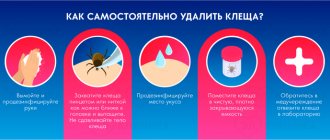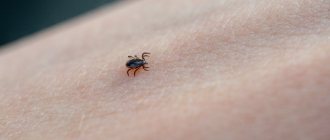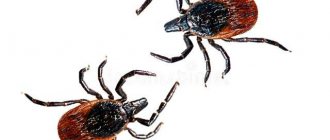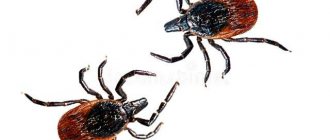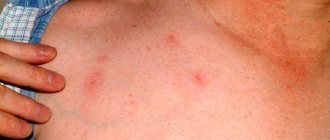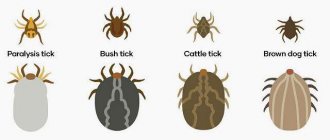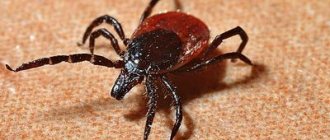Springtime brings with it a charge of positive emotions; nature awakens in all its diversity, including the world of insects. Not all of them are friendly to humans, and some are quite dangerous. Some of them are not easy to get rid of. For example, you need to know exactly how to remove a tick and not harm your health or the well-being of a loved one who has become the target of the parasite’s aggression. There are several proven methods for removing the pest. It is better not to touch it with your fingers, but to use special devices for removing them, which can easily fit in a pocket or small compartment of a backpack.
If you need quick and effective treatment of an area against ticks, we recommend contacting EcoSept!
Tick habitats
Nowadays, you don’t have to go into the forest to find a tick on your clothes or skin. It is enough to walk through a city square or on the grass near your house to pick up this parasite. Not all people know what these blood-sucking arthropods look like.
Ticks belong to the order Arachnids. Currently, 650 of their species are known, most of which are harmless to humans. Among them there are also carriers of serious health diseases:
- tick-borne encephalitis;
- borreliosis.
It must be remembered that a tick bite may not be felt, because when the skin is damaged, it releases saliva containing pain-relieving components. It is not surprising that a person can notice a parasite on his body only some time after the bite. It is advisable to detect it when the tick has not yet penetrated deep into the skin. Then it's easier to pull it out.
If the tick was not found
What if the tick was not detected in a timely manner and remained in the human body? The situation is very dangerous in its consequences. Doctors say that during the first 24 hours after a bite from an infected parasite, infection usually does not occur. The human body becomes infected on the second or third day. This is why it is important to eliminate the insect as early as possible.
The following recommendations will help you avoid further unpleasant consequences:
- Body inspection . After a walk in the forest, the whole body must be examined. Repeat the procedure the next day. By this time, the bite site, which was not detected on the first day, may become red or swollen.
- Human well-being . If, a few days, and sometimes weeks, after a walk in the forest, your health suddenly deteriorates for no apparent reason, you should immediately consult a doctor. The following symptoms indicate a possible infection:
- hyperthermia (temperature can rise to 39°...40°C);
- redness of the chest, neck, face;
- headache;
- excessive weakness;
- nausea, vomiting;
- muscle pain (bothering the back, neck, limbs, lower back);
- skin rash;
- the appearance of red circles around the bite (typical of borreliosis).
The need to examine the body after a walk in the forest is often ignored by those people who have been vaccinated. Even having noticed a tick bite, they do not attach any importance to it and do not visit the hospital. It should be remembered: vaccination only protects against tick-borne encephalitis. But the risk of contracting other diseases still remains.
To protect yourself from a bite, you need to properly prepare for a trip to the forest. It is advisable to choose clothing that provides maximum protection to all areas of the body. They must tie a scarf on their head or wear a brimless hat. And clothes can be treated with special solutions that repel blood-sucking parasites.
Features of behavior
Evolution has helped ticks acquire qualities that have helped them exist successfully for many hundreds of years. They can sit quietly for a long time on tall grass or bushes. When the opportunity arises, they jump on animals or humans. This is basically how ixodid ticks behave - they are carriers of dangerous diseases. They don't bite right away. First, the parasite crawls along clothing from bottom to top, trying to find a suitable place.
If the tick has burrowed under the skin, it means it has been found. Typically, it bites where blood vessels are close to the surface of the body. It can take him up to 3 hours to find such a place. During this time you can easily get rid of it. After the location is found, the tick bites and gradually immerses its head into the skin to get to the blood. His abdomen remains outside.
It is easy to detect a tick under the skin, although this is a rather rare occurrence. It looks like a small tumor, but when you touch it you can feel a hard lump. The behavior of bloodsuckers depends on their species. Some, having drunk blood, fall off on their own after about 3 hours. These are mostly males. Females penetrate deeper into the subcutaneous tissue.
What to do with a removed tick
Throwing out a parasite is reckless, and squeezing is useless. Collected ticks are burned along with a piece of cloth, napkin or cloth, if they were purposefully collected on the territory. When an insect is removed from human skin, it is recommended that the individual be sent to a laboratory. This will make it possible to accurately determine whether she is a carrier of a dangerous disease and which one. Information is necessary for further monitoring of well-being and tracking the most striking symptoms during the period of possible incubation, since treatment is effective precisely at the first manifestations of the disease.
For preventive purposes, immunoglobulin or doxycycline is prescribed. The doctor makes the appointment, he also writes the prescription and observes the patient. If the study shows that the tick is not a carrier of any pathogen, then emergency chemoprophylaxis is not carried out.
Before the spring season, it is worth purchasing a device in advance for the safe removal of ticks and meeting a possible aggressor in full combat readiness.
Bite symptoms
Many people wonder whether a tick can completely crawl under a person’s skin. There are species that are not able to penetrate the subcutaneous layer, live there and reproduce. They bury only the head with the proboscis into the skin, and the abdomen remains outside and swells as the parasite is saturated with the blood of its victim. How to recognize a tick under the skin? Signs that indicate that a person has been bitten by a tick include:
- the appearance of a small wound on the skin for no apparent reason;
- redness around the wound;
- a small round and smooth compaction appears in the center of the spot;
- rapid and unexpected appearance of a dark mole.
The occurrence of these signs indicates that a person has a tick under the skin. You shouldn't panic, but you shouldn't be careless about it either. If you have never pulled out ticks, there is one rule to remember. There is no need to pull out the parasite or make sudden movements trying to throw it off the body. In this case, its head may come off and remain under the skin.
Structural features of the tick's nutritional organs
Once it has attached itself to an object with sharp claws at the ends of its legs, the tick bites into the victim. The oral apparatus is very complex in structure, performing several functions at once, providing blood flow and at the same time additionally fixing the ectoparasite on the skin of a person or animal. That is why difficulties arise with how to get a tick from a person without damaging the insect itself and without provoking the release of its saliva. The proboscis is covered with spines; they prevent the pest from being easily removed by getting stuck in the skin. You cannot try to pull out the parasite with a jerk, this is useless and dangerous, especially since during the feeding process not only the proboscis and the first pair of chelicerae are immersed in the epidermis, but also the head of the blood-sucking insect, for which purpose the upper stratum corneum is first cut through.
Important: the mite is able to regulate the depth of penetration of the proboscis into the skin. The deeper it goes, the more difficult it is to figure out how to remove a tick from a person on your own, without a threat to health, since the chance of developing inflammatory processes increases.
How to remove a tick
If you see a bloodsucker attached to your body, then you need to get rid of it quickly. If you have the opportunity to go to a clinic, then visit a doctor who will quickly remove the tick and treat the wound with antiseptics. You should also consult a doctor if the tick's head remains under the skin, as suppuration may occur. An inept attempt to remove the parasite will lead to the fact that the tick may go deeper under the skin.
This phenomenon is extremely rare and dangerous. If you can’t visit a doctor, you should try to get the bloodsucker out yourself. Here are some recommendations on how to do this correctly:
1. If a person has a tick under his skin, how do you pull it out without tearing the body off the head? The surest way is to use a special device that is sold in pharmacies. Outwardly, it looks like a fork with two teeth. The tick body is passed between them. Next, you need to start turning the device counterclockwise, gradually removing the tick. The advantage of this device is that the body of the parasite remains intact. There is no danger that some part of it will remain in the human skin.
2.If there is no such device, then you can use simple cosmetic tweezers. It should be placed as close to the surface of the skin as possible. The body of the parasite is grasped with tweezers. Next, they begin to turn the tool counterclockwise and gradually remove the tick from the human body.
3.If you don’t have a hook or tweezers, you can use a strong thread.
A loop is made from it, which is placed over the tick. The thread should be placed as close to the victim's skin as possible. Next, you need to start gently rocking the parasite. In this way, it is gradually removed from the human body.
4.If the tick is deep under the skin, then it is better to visit a doctor who will remove the parasite and treat the wound.
After the tick is removed, you need to disinfect the bite site and take an anti-inflammatory medicine. To be sure that the bloodsucker is not a carrier of a dangerous disease, you need to place it in a clean jar with a tight-fitting lid and submit it for analysis.
What should you not do if you are bitten by a blood-sucking parasite? There is no need to drip oil, gasoline or other harmful substances onto it. It is believed that this forces the tick to get out of the victim’s body on its own. However, this does not always happen. You will only waste time and complicate the process of removing the parasite from the body.
Signs of a bite and why it is dangerous
Blood-sucking insects of the parasitic type are very leisurely; they know that as soon as contact is found with the carrier, the percentage that they will not be able to bite is negligible. Protective coloring and small size make the pest almost invisible on dark and colorful clothing. From the moment of preparation to direct attachment to the skin, it can take about 20 minutes.
At the stage of blood sucking, anticoagulants enter the host tissue, preventing the process of blood clotting and the parasite can feed for a long time. They act like a pain reliever and the person does not feel discomfort. Removing a tick at the initial stage, before the bite, is possible with care and a certain amount of luck. Even while the ectoparasite is feeding, it can only be noticed visually upon careful examination.
Only when digestive enzymes of saliva are injected into the wound and partial dissolution of the surrounding tissue begins, local inflammation develops, itching, a burning sensation appears, and the temperature may rise. Externally, this is expressed in redness, swelling, and compaction, which can be easily felt with your fingers.
The danger lies not in the bite itself, but in the saliva of the pest, along with which the pathogens of Lyme disease and tick-borne encephalitis can penetrate. They are severe and can lead to disability. The most dangerous are ixodid forest ticks and the meadow variety.
Preventive measures
To protect yourself from ixodid tick bites, you must take precautions while walking in nature. Particularly dangerous periods are spring and early summer. At this time, ticks are especially aggressive, as they experience severe hunger after hibernation.
When going for a walk, you need to take all precautions to protect yourself from getting ticks on your body. To do this you need to follow simple rules:
- Choose clothes that cover almost the entire surface of the body. Ticks live in tall grass, so they first fall on their feet. Gradually they rise up, trying to find a bare area of skin. When walking you need to wear long trousers and closed shoes.
- Clothing should be worn in such a way as to prevent the entry of parasites. The bottom of your shirt or T-shirt must be tucked into your trousers. Pants legs should be tucked into socks. The shirt must have long sleeves. If it is cool, you should wear a light jacket with a hood. If it is hot, then the head should be protected with a cap or hat.
- During a walk, clothes should be periodically inspected in order to notice parasites in time. If you are going to spend the night in the forest, you need to inspect your sleeping bags and tents.
- It is advisable that clothes for hiking be light in color, since it is harder to notice ticks on dark ones.
- Currently, there are a large number of protective drugs that can repel parasites. These are special gels, sprays, aerosols, ointments. You can buy them in a store or pharmacy. The most popular: “Biban”, “Taiga”, “Picnic-Antiklesch”, “Tornado”, “Deta-Vokko”.
Acaricidal agents
These agents have nerve paralytic properties and paralyze ticks. If ticks come into contact with clothing treated with this composition, complete paralysis of the limbs occurs and they fall dead from the fabric.
These include:
- "Reftamid taiga";
- “Picnic-Anticlesh”;
- "Tornado-anti-mite";
- "Gardex anti-mite."
These products should not be sprayed onto clothing worn directly by people. It is first processed, and only then put on the body. Such clothing can retain its protective function for 10-12 days.
Mites under the skin
A large number of parasitic creatures live on humans. The subcutaneous layer is the habitat of some types of mites. Many of them are pathogenic. These include scabies mites and demodexes.
The latter are opportunistic. This suggests that the human body is able to cope with these mites on its own if there is a strong immune system. Demodexes live on the human body, but do not cause harm. If the immune system is weakened, ticks begin to actively reproduce. In this case, the disease demodicosis occurs.
Depending on the area of the skin in which mites parasitize, they are divided into types:
- Demodex folliculorum. They live in hair follicles.
- Demodex brevis. This species lives and reproduces in sebaceous ducts and glands.
What does a tick look like under the skin of a person? This can be seen with multiple magnifications. the parasite is 0.4 mm in size and is not visible to the naked eye.
If the head of the parasite remains in the body
What to do if the tick ruptures and the head of the parasite remains in the human body? In this case, you can resort to the following methods:
- Using thread . If a small part of the parasite remains on the surface, then you can use the method described above with a loop.
- Removal with a needle . You will need a regular sewing needle. It is pre-disinfected or heated over a fire. Then the remaining head of the parasite is carefully pryed with the tip (based on the principle of removing a splinter) and pulled out of the wound.
Sometimes you can come across a recommendation to leave the head in the body. This fragment will rot over time and will be rejected by the human body. Whether to listen to this recommendation or not is up to everyone to decide for themselves. But it should be remembered that the head of the tick also contains particles of infection, which all this time (albeit in small quantities) continue to poison the body.
How does demodicosis infection occur?
Many readers are interested in whether a tick can crawl completely under the skin. The answer is yes. Demodexes live, feed and reproduce under the skin. This species has two routes of infection - direct contact with an infected person or through common household items: clothing, bedding, towels, and so on.
Demodexes can remain on the surface of the skin for up to three hours. Next, they penetrate the hair follicle or sebaceous gland, where they begin to actively feed on the epithelium and adipose tissue.
Most often, they choose to live on the face, back or cervical region of a person. On the face, the area of the nose, eyes, eyelashes and eyebrows are mainly affected. However, Demodex can live on any part of the body.
How long does it take for a tick to drink blood?
Many people are interested in the question: “How long does it take a tick to drink blood?” In answering this, it should be noted that the duration is significantly different for male and female individuals. We can say that males pose a great danger, since they become saturated with blood very quickly. A person may find a tick already crawling and think that the bite has not yet occurred.
The female, on the contrary, requires a long time to be completely saturated, usually several days. She is able to consume 100 times more blood than her body weight. Before breeding, they feed on food for 10 days. Therefore, it is easier to detect them during the absorption process.
The time required for complete saturation of the parasite also depends on the stage of development and the previous period of hunger. The nymph gets drunk much faster than the adult. If the ixodid tick has been starving for more than 4 months, then it will take much longer than usual to become completely saturated.
Thus, it is impossible to say unambiguously how long it will take the tick to become completely saturated. The process can last from two hours to 14 days. But in most cases, enough time passes to detect the parasite on the body.
Causes of demodicosis
An opportunistic tick begins to activate in the presence of the following reasons:
- Unhealthy eating. Excessive content of glucose and easily digestible carbohydrates in tissue and blood cells causes activation of the tick, since this substance is an excellent nutrient medium.
- Sharing common household items or clothing.
- Passive lifestyle. This leads to a decrease in the body's resistance.
- Treatment with antibiotics and hormonal agents.
- Presence of chronic diseases.
- Stress and nervous tension.
- Immunodeficiency.
- Use of low-quality cosmetics, leading to clogging of sebaceous ducts, glands and follicles.
What happens after saturation
As already mentioned about females, they drink blood for quite a long time. Most often at this time they become noticed and manipulations are carried out to remove them. But if the procedure went unnoticed, then the tick disappears after the bite. Females lay offspring, males look for females to mate with.
When the parasite was not noticed on the body, the person observed the consequences in the bite area. Most often, symptoms such as redness, inflammation, and itching appear, which disappear after a while. But allergic reactions that occur in severe forms may occur; in such situations, it is imperative to consult a doctor and use the correct treatment.
When the tick has sucked and fallen off, redness, slight swelling, and slight itching remain at the site of the bite. The skin is restored within a few days. In the presence of an allergic reaction, special treatment is required - the use of local, systemic antihistamines, antiallergic drugs. If the tick has been infected, symptoms of the disease appear after 14–60 days.
Signs of demodicosis
Infection occurs when a tick gets under the skin. What to do in this case? How to determine the onset of the disease? The first sign of the presence of this parasite is a general persistent redness of the facial skin. Further symptoms:
- The appearance of acne with ulcers on the face.
- Inflammation, irritation and hardening of the skin around the eyes, increased tearing, dryness, the appearance of stye that does not respond to conventional treatment. As the disease progresses, the cornea becomes damaged and vision decreases.
- Dilated blood vessels.
- Purulent rashes on other areas of the skin.
Direct sunlight helps reduce the area of inflammation.
If the arachnid fell off at home
In a situation where the parasite bites a person and falls off after a few hours, it often goes unnoticed. A red spot, slight inflammation, and slight itching remain on the body. The tick falls off if it has fully satisfied its need for food and replenished its nutritional reserves.
Tick drunk on blood
If a thick tick falls off at home, there is no future for it. The nymph will not be able to continue development because there is no soil. The female will not be able to lay eggs for the same reasons. After some time, the parasite dies. The tick is dangerous if it has not drunk blood, then it can bite again. There is no need to worry too much about where the tick goes in the apartment. Even if he is not discovered, he will soon die.
Therapy for demodicosis
The main method of control is complex treatment, which consists of the external use of special ointments, creams, solutions, as well as strengthening the immune system.
It should be borne in mind that only by eliminating the causes of the disease can good results be achieved and relapses avoided.
Doctors recommend regularly cleansing your facial skin with special cosmetics and doing mild peeling. Patients may be prescribed Permethrin and Metronidazole ointments. The full course of treatment for mites under the skin usually lasts just over a month.
What can you become infected with?
If the tick itself came out and crawled away, this does not mean that it did not harm the human body. Ixodid ticks are carriers of various diseases. Particularly dangerous are those that are carriers of borreliosis and encephalitis. If a bite is detected, whether the tick is still there or has already fallen off and disappeared, you must immediately seek help from qualified specialists and monitor for symptoms of tick-borne encephalitis.
Lyme disease or borreliosis
Borreliosis manifests itself in the early stages in pain in the head, muscles, joints, fever up to 38 degrees, vomiting and deterioration in general well-being. Rare symptoms include sore throat, cough and runny nose. If intervention is not done in a timely manner, the lymphatic and nervous systems are affected. As the disease progresses, it can cause damage to the facial nerve and seriously affect the brain, for example, a person loses memory or the ability to think adequately.
If treatment is started on time, then in most cases it is possible to completely cure it with the correct selection of medications. When delayed, the complexity of therapy increases many times over; it does not help in all cases.
Tick-borne encephalitis
The Ixodid tick is also a carrier of encephalitis. If a person does not notice a tick bite in time, he risks becoming infected in approximately 60% of cases, these are official statistics. Tick-borne encephalitis is a dangerous disease; in the early stages it manifests itself with the same symptoms as borreliosis. Additional tachycardia and rapid heartbeat may be added, but there is no red round spot with a ring.
The extent of symptoms depends on the number of mites and the person's individual allergic reaction. It’s hardest for the elderly and young children.
A critical increase in temperature to 39-40 degrees requires immediate contact with doctors for resuscitation measures, otherwise you can die in a fever. Therefore, you should not delay even with the most minor symptoms.
If tick-borne encephalitis is not treated, damage to the central nervous system may develop as early as the 7th day. A person may experience epileptic seizures and severe headaches. Toxins begin to accumulate in the body, destroying the kidneys, liver and other vital organs.
It is especially dangerous if the infection occurs in young children. They cannot correctly assess the danger and symptoms that appear to them. It is extremely important for parents to examine their children after a walk in nature, especially carefully in places where ticks are most often found. If you have the slightest doubt, you should immediately go to the hospital.
In addition, ticks carry a lot of other diseases dangerous to human health and life, such as tick-borne typhus, hemorrhagic fever, ehrlichiosis, tularemia and many others. Medicine has learned to cope with all of them to one degree or another if the patient seeks help in the early stages. Delaying it to the last minute can permanently deprive you of your health, and in some cases, your life.
Scabies mites
The sizes of these parasites are approximately the same as Demodex. Therefore, you can only see what a scabies mite looks like using a microscope. It digs passages under human skin. This causes unbearable itching. Therefore, the second name for the scabies mite is itching. It causes scabies, a highly contagious disease.
Itching can infect any part of the body, but prefers the area between the fingers, perineum and armpits. A man scratches the affected areas. In these places, wounds appear, into which infection penetrates.
Infection occurs mainly through contact with a sick person. Sexual transmission is also possible. Sometimes children who sleep in the same bed with sick parents become infected.
The itching only becomes active at night. A sign of the disease is not only itching, but also a rash.
If scabies is diagnosed, quarantine is declared. Therapy is carried out using special ointments. In this case, all people in contact with the patient should receive treatment.
For scabies, medications containing peritrins or benzyl benzoate are used. Doctors can prescribe Spregal, Lindane, Crotamiton, Ivermectin, and sulfur ointment.
After the destruction of ticks, medications based on antibiotics “Neomycin” and “Baneocin” can be prescribed.
Where to look for ticks on the body
For an ectoparasite, saturation with blood is a necessary condition for the further development of the body; the entire system is subordinated to the function of biting and holding on to the body of the victim. Among the adaptation mechanisms, the main one is the search for a power source. Ticks can smell skin, sweat, and body heat from several tens of meters away. At the same time, the parasite very carefully selects hunting sites, prey and the place of attachment to it, preferring the neck, elbow bends, armpits and scalp. It is there that the skin is more delicate, and the chances of detecting and destroying the pest are several times less.
Prevention
It is well known that disease is easier to prevent than to treat. As already mentioned, one of the main causes of demodicosis is a weakened immune system. Therefore, proper nutrition and a healthy lifestyle are one of the main conditions that help to avoid the disease.
To prevent ticks from parasitizing under the skin of a person, you should follow the rules of personal hygiene, constantly wash your hands, and do not use common household items.
It is also necessary to take a shower and visit the bathhouse at least once a week. During this procedure, the pores and sebaceous ducts are cleaned.
It's hard to believe, but scabies mite infection is not related to hygiene. This parasite feels great on both clean and dirty bodies. It can remain on the surface for no more than 30 minutes. During this time, the tick gnaws through the passage and hides under the skin. A preventative measure that will help avoid infection with this parasite is to minimize physical contact with strangers.
Compliance with all these measures will protect you not only from diseases caused by subcutaneous mites, but also other dangerous ailments.
Ticks are dangerous only in May and June
The first period of tick activity in Russia begins in early April and lasts until mid-June, and the largest number of bites is traditionally recorded in May. However, we should not forget about the second period of activity - it lasts from the beginning of August to the beginning of... October. And the chances of encountering a tick in the fall are especially high for residents of regions with warm climates. By the way, a tick can attach itself to its victim even in winter. So, in 2011, a five-year-old girl from Rostov-on-Don fell victim to a bloodsucker, and it happened on New Year’s holidays.
COMPLICATIONS AFTER A TICK BITE
Summarizing all of the above, we can draw a very disappointing conclusion about the consequences of a tick bite. As you can see, infections affect the most important systems of the body:
- lungs - with the development of symptoms of pneumonia and pulmonary hemorrhages;
- liver - indigestion, problems with stool (diarrhea);
- CNS - with frequent headaches, hallucinations, paresis and paralysis;
- cardiovascular system - arrhythmia and blood pressure surges appear;
- joints - arthritis and arthralgia are formed.
The consequences of a tick bite can develop in two ways. With a favorable outcome, loss of performance, weakness and lethargy continue for 2–3 months, then all body functions return to normal.
For moderate illness, recovery lasts up to six months or longer. A serious form of the disease requires a rehabilitation period of up to 2–3 years, provided that the disease proceeded without paralysis or paresis.
If the outcome is unfavorable, there is a persistent and long-term (or permanent) decrease in the quality of life of the victim of a tick bite. Manifests itself as a violation of motor function. The clinical picture worsens significantly under the influence of nervous and physical fatigue, pregnancy, and regular alcohol intake.
Persistent disorders in the form of epileptic manifestations and spontaneous convulsions lead to the patient's incapacity.
Disability as a consequence of a tick bite
As you know, there are 3 groups of disabilities. The degree of damage to the body after a tick bite is determined by a special medical commission:
- Group III disability - mild paresis of the arms and legs, rare epileptic seizures, inability to perform highly skilled work that requires precision and attention.
- Disability of group II - severe paresis of the limbs, partial paresis of muscles, severe epilepsy with mental changes, asthenic syndrome, loss of the ability to self-care.
- Group I disability - acquired dementia, severe motor dysfunction, persistent and complete epilepsy, widespread muscle paresis, loss of self-control and inability to move independently.
In especially severe cases, with inadequate treatment of infections caused by a tick bite or complete lack of therapy, death is possible.
INSURANCE AGAINST TICK-BORNE ENCEPHALITIS
Recently, insurance for expenses associated with possible encephalitis after an “encounter” with a tick has become widespread. This measure is often used as an addition to vaccination or as an independent measure.
Insurance will help pay for expensive treatment for tick-borne encephalitis and other infections carried by bloodsuckers.
The irreparable consequences of a tick bite can be prevented if you seek medical help in time and begin treatment. Remember, an attached parasite does not immediately transmit the infection. The longer it stays on the body, the greater the risk of contracting tick-borne encephalitis or Lyme borreliosis.
TREATMENT OF TICK BITE VICTIMS
If a tick has bitten and the test results reveal an infection, the patient is given immunotherapy based on doctor’s prescriptions. Further treatment depends on the type of pathogen that has entered the body.
Treatment of patients with tick-borne encephalitis
There are currently no specific treatments for tick-borne encephalitis. If signs of central nervous system damage appear, the victim must be hospitalized to provide medical care. The treatment regimen includes:
- Bed rest during the entire duration of the fever and a week after it ends.
- In the first days of the disease, administration of immunoglobulin is indicated. To achieve the best result, it is necessary to apply the product as early as possible, preferably in the first three days after the tick bite.
- In general cases, the patient is prescribed corticosteroid drugs and blood substitutes.
- For meningitis, increased doses of vitamins B and C are administered.
- If respiratory functions deteriorate, the victim is advised to receive artificial ventilation.
During the recovery period, the patient is prescribed nootropics, tranquilizers and testosterone simulators.
As an addition to the main treatment, antibiotics may be prescribed to the bite victim. Antimicrobial drugs are used to suppress pathogenic microflora that can cause various complications.
Therapy for patients with borreliosis
Treatment for Lyme borreliosis involves taking antibiotics. They are used to suppress spirochetes, the causative agents of the disease. The most commonly used drugs are penicillins and cephalosporins. To relieve erythema, antimicrobial agents of the tetracycline group are prescribed.
If neurological disorders appear, the victim is hospitalized. In the hospital, complex therapy is carried out, including:
- blood substitutes;
- corticosteroids;
- testosterone mimics;
- nootropic drugs to improve cerebral circulation;
- vitamin complexes.
The outcome of borreliosis depends on the timely detection of a tick bite, correct diagnosis and early initiation of therapy. Incompetent treatment often leads to the chronic phase of Lyme disease, which is difficult to treat and can result in disability or death of the victim.
Attention. To treat protozoal infections, medications are used that prevent further growth and development of protozoa.
